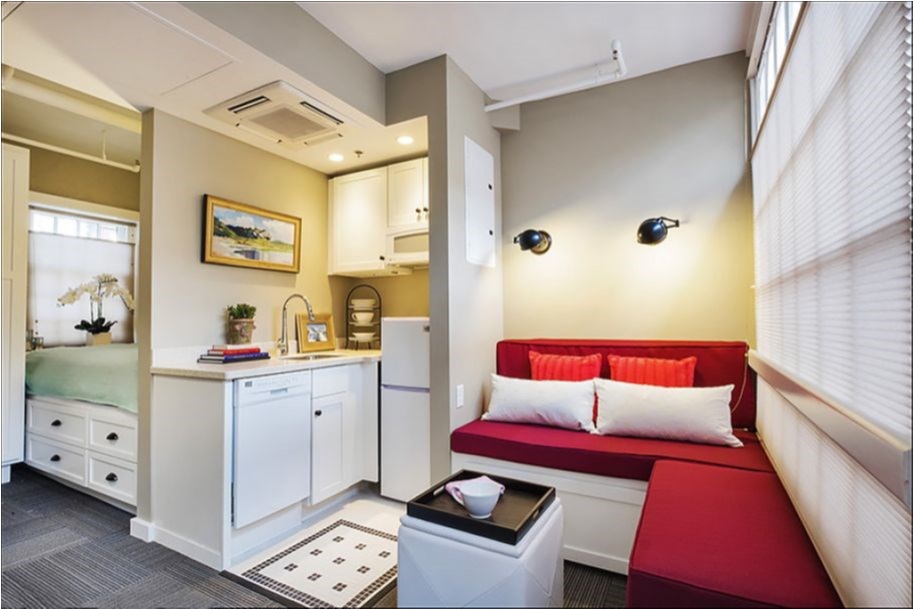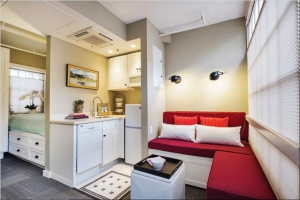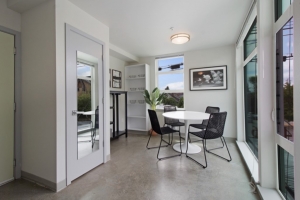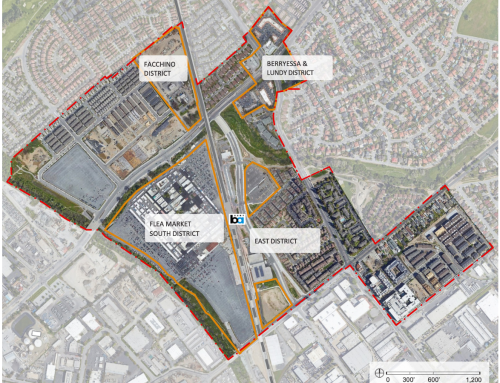By Sarah Hoban | CIRE Magazine
IIn Seattle, they’re called SEDUs – small efficiency dwelling units. In Boston, they’re known as innovation units. Chicago has a group of them called Flats. But while there’s variety in what developers call tiny apartments, there’s no question they are big news.
Within the industry, these spaces are called microunits, and while there isn’t a hard and fast definition for them, it’s agreed they are very small apartments, generally ranging between 250 and 500 square feet. Different markets may define “micro” differently, and some blur the definition between microunit apartments and terms like “co-living,” which may entail a building with separate bedroom units and shared common facilities.
But microunit apartments are generally fully self-contained dwellings with bathroom and kitchen areas. There’s room for a bed – which may fold into the wall or double as a couch – and storage is cleverly designed to maximize the unit’s limited space. “To put the size of a microunit into perspective, a 300-square-foot studio apartment is slightly larger than a one-car garage, but considerably smaller than a two-car garage,” notes a 2014 Urban Land Institute study, “The Macro View on Micro Units.” Nationally, new apartments of all sizes are getting smaller overall. According to data gathered by Yardi Matrix last year, the average size of new apartments in the U.S. was 941 sf, which is 5 percent smaller than a decade ago. (And studio apartments shrunk the most – more than 10 percent). At the same time, overall rents increased by 28 percent over the same 10 years. Microunits have become most popular – some would argue necessary – in urban areas where rents have soared and housing stock has plummeted. Cities like New York, San Francisco, and Seattle are leaders in the trend, but microunits are also turning up in markets like Charlotte, N.C., and Minneapolis.
The units are most appealing to young professionals who are willing to give up space for lower rent, proximity to work, and the ability to live in a desirable neighborhood. “In a city like Seattle, very few are building affordable options, and they’re being built at a slow pace,” says Jerrid Anderson, senior vice president for the Seattle Multifamily Team for Colliers International. “For folks who want to live in or near the city for around $1,000 a month, a microunit is about the only option in a newly constructed building in a nice location.”
A few other trends have contributed to microunits’ rising popularity. The ULI study points to delayed household formation among millennials, an increase in single-person households, a decrease in car ownership among younger city dwellers, and the growing “sharing economy,” which cuts down on unnecessary household possessions. Despite their diminutive size, microunits aren’t cramped, dark boxes. Individual units have large windows, high ceilings and sleek bathrooms. Buildings often feature well-appointed communal spaces, such as exercise rooms, rooftop decks, and work areas. But what’s outside the building is just as important. Potential renters surveyed by ULI emphasized the importance of proximity to restaurants, grocery stores, shopping, entertainment, and public transit.
CRE Issues and Challenges “I think there are two camps that are evolving on the issue,” says Charles Hewlett, managing director and director of strategic planning and litigation support for RCLCO in Washington, D.C. “One camp believes that this is a fad, a flash in the pan being driven by a resurgence in interest in the urban environment, and that it might wane as the young folks start getting married and having kids. Generational owners of rental apartment communities are concerned: ‘What do I do 10 years from now, if I’ve got these tiny units that no one wants to rent?’ Some people are eschewing microunits because they’re concerned about their long-term viability.” The other camp, says Hewlitt, who was a member of the research committee for the ULI report, “believes that this is a viable segment and product type that is relevant for certain locations. It’s not affordable housing – let’s not kid ourselves; these are still very expensive apartment homes. But the selling proposition is that you get to trade o
Zoning and Density Laws
Microunit construction has faced opposition in several cities, including concerns about density and overbuilding. “It’s an issue,” says Hewlett, “and it’s a real patchwork. There’s no blanket statement for across the country.” Developers, he says, must work with municipalities and may need to get special zoning classification. Anderson agrees and recommends working with local architects who are familiar with zoning codes. “If you’re looking to bring them to a new city, I would definitely get involved with an architect whose had experience with them. But we’ve also had success with clients who have gone to different cities and said, “Here’s something that’s working in Seattle – I’d love to do it here.”
Financing and Appraisal
“In the last four years, lenders have done a complete 180 as far as how they treat the product type,” says Anderson. “When we started, there were definitely some misconceptions among the lending and appraisal communities. [They thought] micro expenses would be just as high as market rate, and that was a major miss. These operate sometimes for less than half a market rate per unit. Once appraisers had more comparable appraisals and sales to justify the lower expense numbers and lenders saw that they actually operate around the same exact occupancy rate, if not lower than market rate, they got more comfortable with it.
“We don’t see any spread on interest rates over what the local lenders can offer for these buildings over market rate. Furthermore, we have several micro buildings in the city and surrounding area that have agency financing; for Freddie Mac, it fits in its affordable umbrella, and it’s an uncapped line of business, so they are, as often as possible, trying to underwrite and place very attractive debt on these properties.”
Investors
“The buyer pool [for microunit buildings] was very small initially,” says Anderson, “But it’s growing. When you take a traditional investor, who’s used to looking at traditional one- and two-bedroom apartments, and take them into 200 square feet, if they’re not prepared for it, it can be shocking.” In Anderson’s case, focus made a difference. In the last four years, his team has marketed more than a dozen micro properties. They’ve produced market studies and hosted four micro-specific events. “We’ve been able to get a large number of investors through these buildings, explaining the benefits and allowing the buildings to speak for themselves,” he says. “They’re maintaining high occupancy rates, quick turnovers, and frankly, just better cash flow than a lot of the market-rate apartments in the area.”
Building and Operating
Unfortunately, says Hewlett, national data on microunit construction and operating costs is lacking. “The hypothesis is that both of those things are higher. Yes, you get higher rents, so you get better dollar per square-foot/value ratios. But you still have to build a kitchen and a bathroom. The difference between a 350-sf unit and a 500-sf studio is building a living room and a bedroom – it’s only drywall – so the base costs of the unit are similar.
“And for operating costs, turnover tends to be higher, and the wear and tear tends to be a little higher. The supposition is that when you look at a contribution margin for these units, it might not be as attractive as a conventional studio.” “We have clients who have everything that you’d expect in a traditional apartment – a full-sized washer and dryer, air-conditioning, and different creature comforts in the unit,” says Anderson. “Those are very expensive units to build relative to their size, and for their pro forma to work, they need to achieve a much higher rent per foot. When micros rent for near the same price as a studio, they’ve had trouble stabilizing those buildings. Our experience has been you must right-size the finishes so you can still offer an affordable unit. What we’d expect is hard surface flooring, hard surface countertops, mid-grade cabinets, and mid-grade bathroom improvements, while not going above and beyond in appliance quality or even appliance offerings.”
For example, he says, some individual apartments may only have a microwave or countertop burner, and each floor might have a full-sized kitchen that tenants can share. Hewlett says he knows instances of communities that have eliminated one unit per floor and turned that area into a communal gathering and entertainment space. Correct rental pricing is key. “As long as the asking price for the units is approximately $250 less than the next-most affordable studio, they do very well,” says Anderson. “In Seattle, if studios are around $1,500 per month, and micros are running for about $1,250, they do fine. If someone builds the nicest micros and asks $1,400 per month, they don’t do as well.” Hewlett notes a similar figure – the rent sweet spot, he says, is around 20 to 25 percent below a conventional studio.
With a young and often-transient market for microunits, leasing and turnover can be a concern. “They definitely have a higher turnover rate,” says Anderson. “We’ve talked to dozens of owners. Some near the University of Washington have experienced as much as 100 percent turnover, while other in markets with fewer affordable options have seen turnover as low as 40 percent. We’ve gravitated to about 70 to 75 percent turnover as what you can expect. Most management companies and owners are signing nine- to 12-month leases, making sure they’re staggered, just as you would in a market-rate building.” But, he adds, the demand for the units means that they lease quickly. “The drawback is you have higher leasing staff expense,” he says. “The benefit: When you do lease, you can usually turn the unit within a day and sign a lease within a week.”
“In good locations, and with a good economy, I think the depth of the market for a certain percentage of these is very robust,” says Hewlett. “I haven’t heard of any problems that any communities have had in good locations renting microunits.” At the same time, he has observed one notable piece of planning. Some developers are building flexibility into their communities. One building in Washington, D.C., for example, features a mix of microunits along with conventional apartments. The micros are built in separate bays of the buildings. “If the market was moving away from these smaller units in 10 or 20 years, they could break through the wall between two microunits and turn the space it into a conventional one-bedroom unit.” Hewlett says. “They would lose the investment of one of the bathrooms and one of the kitchens, but they wouldn’t have two units that they couldn’t rent. Forward thinking and smart design professionals and developers are looking at how to create flexibility into their design so that if that market moves away, they can convert.”
Anderson’s advice for those considering getting involved in microunits: “Get out and see them. When you see a 250-square-foot unit, well designed, with nice large windows, hard-surface flooring, new appliances – it shows and lives really well. It’s easy on paper to think that this thing is uninhabitable and smaller than a mousetrap, but you get in it and see how – at various points in your life – you easily could live in one of these units and save quite a bit of money.”









